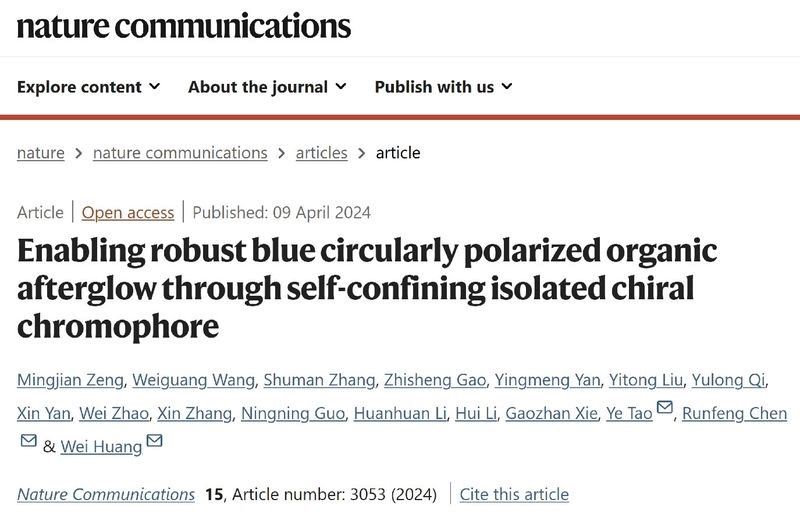Recently, Prof. Tao Ye and Prof. Chen Runfeng from Academician Huang Wei's team at the State Key Laboratory of Organic Electronics and Information Display, Nanjing University of Posts and Telecommunications (NJUPT), have made new progress in the field of chiral organic long afterglow. A simple method to obtain blue chiral long afterglow by covalent self-limiting domain chiral chromophores is proposed, and blue chiral organic long afterglow polymers with ultra-long lifetime and high luminescence asymmetry factor are designed. The team blended the blue chiral long afterglow polymer as the main body with the fluorescent guest, and utilized the synergistic energy transfer strategy of afterglow and chirality to successfully realize the construction of a full-color chiral long afterglow emission system, and explored the application of this kind of material in the fields of information encryption and three-dimensional display.
The results were published in Nature Communications on April 4 under the title of Enabling robust blue circularly polarized organic afterglow through self-confining isolated chiral chromophore. Prof. Tao Ye, Prof. Chen Runfeng and Academician Huang Wei of College of Materials Science & Engineering are the co-corresponding authors, master Zeng Mingjian the first author of the paper, undergraduate Wang Weiguang the second author of the paper, and Prof. Wang Leyong of Nanjing University has given great support in the circular dichroism spectroscopy test.

Nature Communications publishes research progress in the field of chiral organic afterglow by Prof. Tao Ye and Prof. Chen Runfeng from the team of Academician Wei Huang at the Key Laboratory of Organic Electronics and Information Display
Chiral organic long afterglow has broad application prospects in many fields due to its special photophysical properties. Researchers have made some breakthroughs in regulating the lifetime and color of chiral long afterglow materials through crystal engineering, host-guest doping, polymerization, etc. However, due to the difficulty of simultaneously obtaining chiral luminescence with high triplet state energy levels, low non-radiative jump rates, and effective chirality, the development of blue chiral long afterglow materials with ultra-long lifetimes and effective chiralities is still a formidable challenge.
To address this problem, a team led by Academician Wei Huang, Professor Runfeng Chen, and Professor Tao Ye proposed a simple and efficient strategy: by introducing isolated chiral chromophores into rigid polymer matrices with self-limiting domains and sufficiently suppressing non-radiative leptophores, a blue chiral long afterglow polymer was designed, which has a lifetime of up to 3.0 s and a maximum luminescence asymmetry factor |glum| value of 1.02 × 10-2. Through further studies, a full-color chiral long afterglow polymer with color tunability was achieved by doping commercial water-soluble fluorescent materials under the effect of synergistic energy transfer between afterglow and chirality. This result not only provides a feasible way to develop blue chiral long afterglow materials, but also illustrates the feasibility of the afterglow and chiral synergistic energy transfer strategy to construct full-color chiral luminescent materials.
The research results have been supported by National Basic Science Center for Flexible Electronics, Excellent Young Scientists Fund, Jiangsu Provincial Distinguished Professor Program, the Director's Fund of Key Laboratory of Organic Electronics and Information Display, the open project of Songshan Lake Materials Laboratory, and the “Huali Talent” support program of NJUPT.

Figures : (a) blue and full color chiral long afterglow luminescent polymer construction strategy; (b) full color chiral luminescence spectra (c) the photos of long afterglow
(Written by Tao Ye Initially Reviewed by Gao Zhihua, Ling Haifeng Edited by Wang Cunhong Reviewed by Zhang Feng)



